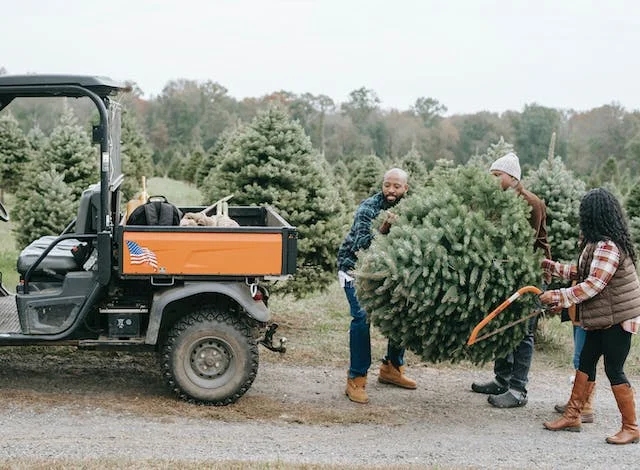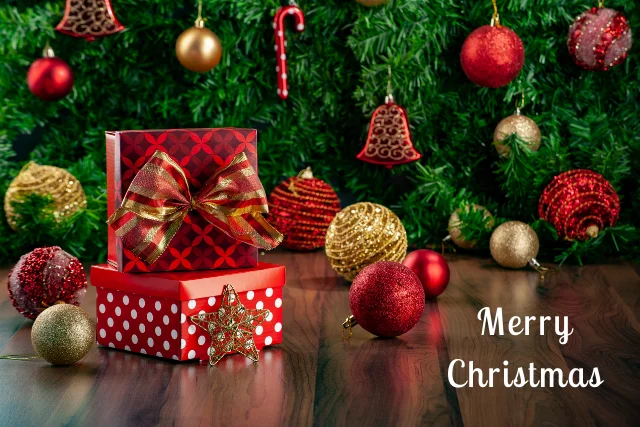As an Amazon Associate, I earn from qualifying purchases. This post may contain affiliate links. If you make a purchase through these links, we may earn a commission at no additional cost to you. Please read our full disclosure here.
As the air fills with the scent of evergreens and twinkling lights illuminate our homes, the quest for the perfect Christmas tree -the centerpiece of festive cheer- becomes a cherished tradition. In this guide, we embark on a merry journey to discover the art of choosing the ideal tree that will not only stand tall in your living room but will also become the heart of your seasonal celebrations. From the subtle fragrance of pine needles to the age-old debate of artificial versus real, join us in unwrapping the secrets to creating a winter wonderland at home.
The Christmas tree has its origins in medieval Europe, influenced by both pagan and Christian traditions. The use of evergreen plants symbolizing life and fertility was present in winter solstice celebrations. The “Paradise Tree” in medieval mystery plays and the German tradition of bringing decorated trees into homes contributed to the Christmas tree’s evolution. Martin Luther’s addition of candles and royal influence, notably by Queen Victoria and Prince Albert, helped popularize the tradition in the 18th and 19th centuries.

Over time, the Christmas tree tradition spread globally and incorporated various cultural elements, becoming a symbol of joy, celebration, and togetherness during the holiday season. Today, the Christmas tree is a central and cherished aspect of Christmas celebrations in many parts of the world.
A Christmas tree is a decorated evergreen coniferous tree, typically a spruce, pine, or fir, or an artificial tree with a similar appearance. Families often bring a Christmas tree into their homes, where it serves as a focal point for holiday festivities.
Choosing a Christmas tree can be a fun and festive tradition for many families. The process of selecting a tree often involves a combination of personal preferences, family traditions, and practical considerations. This guide will help you in the process of choosing the best christmas tree for you and your family.
What Are The Types Of Christmas Trees?
Several types of Christmas trees are popular choices for holiday decorations. Each type has its own characteristics, including the appearance, fragrance, and needle retention. Here are some common types of Christmas trees:
1.Balsam Fir (Abies balsamea): The best smelling Christmas tree
- Appearance: Dark green needles with a silvery underside, and a classic Christmas tree shape.
- Fragrance: Strong, pleasant fragrance.
2. Fraser Fir (Abies fraseri): The most popular Christmas tree
- Appearance: Dark green needles, short and soft to the touch, with a narrow shape.
- Fragrance: Mild fragrance.
3. Douglas Fir (Pseudotsuga menziesii):
- Appearance: Soft, dark green or blue-green needles with a sweet fragrance.
- Fragrance: Sweet, citrusy scent.
4. Scotch Pine (Pinus sylvestris):
- Appearance: Bright green needles, twisted branches, and excellent needle retention.
- Fragrance: Pleasant pine fragrance.
5. White Pine (Pinus strobus):
- Appearance: Soft, flexible needles, bluish-green color, and a fuller appearance.
- Fragrance: Mild to no fragrance.
6. Norway Spruce (Picea abies):
- Appearance: Dark green needles, short, and sharp, with a classic Christmas tree shape.
- Fragrance: Strong, but needles may drop more quickly compared to other types.
7. Colorado Blue Spruce (Picea pungens):
- Appearance: Silvery-blue to green needles, sharp to the touch, and a symmetrical shape.
- Fragrance: Mild to moderate fragrance.
8. Eastern Red Cedar (Juniperus virginiana):
- Appearance: Dark green foliage, a more natural shape, and a compact size.
- Fragrance: Fragrant with a cedar-like scent.
9. Noble Fir (Abies procera):
- Appearance: Dark green needles, sturdy branches, and a conical shape.
- Fragrance: Mild fragrance.
10. Virginia Pine (Pinus virginiana):
- Appearance: Short needles, dense branches, and a traditional Christmas tree shape.
- Fragrance: Aromatic pine scent.
Natural or Artificial Christmas Tree?
The choice between a natural Christmas tree and an artificial one often depends on personal preferences, lifestyle, and environmental considerations. Here are some factors to consider when making your decision :
Natural Christmas Tree
Pros:
Authenticity: Many people appreciate the natural beauty, fragrance, and authenticity of a real Christmas tree.
Tradition: For some families, the process of selecting and decorating a real tree is a cherished holiday tradition.
Environmentally Friendly Practices: Choosing a tree from a sustainable and responsibly managed tree farm can have a lower environmental impact. Many tree farms replant and contribute to local ecosystems.
Biodegradable: Real trees are biodegradable, meaning they break down naturally and can be recycled into mulch.
Cons:
Maintenance: Natural trees require maintenance, such as watering to keep them fresh and minimize needle drop.
Expense: Real trees can be more expensive upfront compared to artificial ones, especially if they are sourced from a tree farm.
Allergies: Some individuals may be allergic to the scent or sap of real trees.
Artificial Christmas Tree
Pros:
Cost-Effective in the Long Run: While artificial trees may have a higher initial cost, they can be a more economical option over several years as they are reusable.
Low Maintenance: Artificial trees require minimal maintenance—no watering, and they don’t shed needles.
Allergy-Friendly: Artificial trees are a good option for individuals with tree-related allergies.
Convenience: Easy to set up, take down, and store for the next holiday season.
Cons:
Environmental Impact: Many artificial trees are made from non-biodegradable materials, such as plastic, and can contribute to environmental waste.
Lack of Authenticity: Some people miss the authentic look, feel, and scent of a real Christmas tree.
Upfront Cost: Artificial trees can have a higher upfront cost compared to a single year’s purchase of a real tree.
What Is The Ideal Size For A Christmas Tree?
The available space for the Christmas tree in the home can influence the size of the tree chosen. Families typically measure the height and width of the space where the tree will be placed to ensure that there’s enough room for the tree to stand securely and for decorations to be displayed effectively.
Christmas trees come in various sizes to suit different spaces and preferences. Here are common categories for Christmas tree sizes:
1.Tabletop Trees:
Tabletop Trees are small trees, usually ranging from 1 to 3 feet in height, ideal for tabletops, desks, or small spaces.
2. Small Trees:
Small trees typically range from 4 to 6 feet in height and are suitable for apartments, bedrooms, or areas with limited space.
3. Medium Trees:
Medium-sized trees range from 6 to 8 feet and are versatile, fitting well in living rooms or spaces with moderate ceiling heights.
4. Tall Trees:
Tall trees can be 8 feet or more in height and are suitable for rooms with high ceilings or for those who prefer a grand and impressive tree.
5. Slim or Pencil Trees:
Slim or Pencil trees are characterized by a narrow profile, making them suitable for tight spaces or as an elegant choice for those who prefer a sleek and modern look.
6. Full Trees:
Full-sized trees have a broader profile and are well-suited for larger rooms where a more substantial presence is desired.
7. Outdoor Trees:
Larger trees, often ranging from 10 to 20 feet or more, are used for outdoor displays and public spaces, creating a festive atmosphere.
How To Ensure About The Freshness Of A Natural Christmas Tree?
Selecting a fresh Christmas tree is essential for ensuring its longevity and vibrancy throughout the holiday season.
- Start by gently running your fingers along the branches, fresh trees should have supple, pliable needles that resist snapping.
- Give the tree a gentle shake; if only a few needles fall, it’s a good sign of freshness.
- Check for a healthy green color, as vibrant hues indicate vitality.
- Another reliable indicator is the fragrance: opt for a tree with a strong, pleasant scent, which suggests that the tree is actively releasing essential oils.
- If possible, inquire about when the tree was harvested, aiming for one that has been recently cut.
- Lastly, inspect the trunk for sap; a sticky, resinous trunk is indicative of a freshly harvested tree.
By paying attention to these freshness cues, you can ensure that your chosen Christmas tree remains a lush and vibrant centerpiece throughout the festive season.
Tips for A Budget-Friendly Christmas Tree
Selecting a Christmas tree that aligns with your budget involves a thoughtful balance between size, type, and personal preferences.
- Artificial trees, while often more expensive upfront, provide a cost-effective, reusable option over multiple years.
- If opting for a real tree, various types come with different price points, with factors such as species, size, and local availability influencing costs. Consider local tree farms, as their prices may be competitive, and you can choose your tree directly from the source.
- Additionally, keep an eye out for seasonal promotions and discounts offered by nurseries or community organizations.
Assess your budgetary constraints and weigh them against the desire for a full, decorated tree that brings holiday cheer without breaking the bank. By being mindful of your budget, you can find a Christmas tree that not only suits your financial parameters but also contributes to a festive and joyful atmosphere during the holiday season.
How To Select a Christmas Tree with Convenience in Mind?
Opting for a Christmas tree that aligns with convenience involves practical considerations to simplify the holiday season. For a hassle-free choice, artificial trees stand out as they require minimal maintenance, can be easily assembled and disassembled, and offer the advantage of reuse for multiple seasons.
Alternatively, if a real tree is preferred, you should:
- Consider pre-cut options available at local nurseries or tree lots, saving time compared to cutting your own.
- Evaluate the ease of transporting the tree to your home, ensuring it fits comfortably into your vehicle.
- Explore tree varieties with sturdy branches that can support ornaments without excessive shedding, reducing cleanup efforts.
- Ensure the chosen tree has good needle retention and consider placing it in a water stand to maintain freshness.
By prioritizing convenience, you can streamline the process of bringing the festive spirit into your home, allowing more time for the joyous aspects of holiday preparation and celebration.
Whether guided by budget considerations, family rituals, convenience, or a desire for a fresh evergreen, the process of choosing the perfect Christmas tree captures the essence of holiday joy. So, as you embark on this annual quest, remember that the beauty of the Christmas tree lies not only in its outward appearance but in the shared moments, traditions, and memories it represents.
May your chosen tree stand tall, radiating the warmth of the season, and may your holidays be filled with the magic that only a carefully selected Christmas tree can bring.




